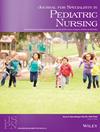使用住院患者复杂性评估和监测以确保最佳结果(CAMEO©)工具的儿科神经科学护理的敏锐度。
IF 1.6
4区 医学
Q3 NURSING
Journal for Specialists in Pediatric Nursing
Pub Date : 2021-01-01
Epub Date: 2020-08-27
DOI:10.1111/jspn.12307
引用次数: 1
摘要
目的:神经科学护士必须具备先进的知识和技能,以照顾各种独特的先天性和获得性神经学诊断。对于每一种临床情况,对患者护理的复杂性和敏锐性的测量是告知人员配置模型和患者分配的关键。住院患者复杂性评估和监测以确保最佳结果(CAMEO©)敏锐度工具根据护理认知工作量复杂性测量患者的敏锐度。我们描述了住院病人CAMEO©在美国东北部一家大型独立儿童医院儿科神经科学部门的实施和评估。设计和方法:采用质量改进方法,住院患者CAMEO©在12个月的时间内由神经科学临床领导和单位大使实施和评估。每月的数据报告评估单位级的完成程度和敏锐度(I-V)的水平被生成给单位领导。数据进一步按神经科学单元的入院类型分层。五类患者包括神经内科、癫痫、神经外科、神经肿瘤学和其他,其中定义为非神经内科患者。结果:每月住院患者CAMEO©s分类为III-V的比例为62.3% ~ 83.3%,中位数为78.2%。神经科学入学的类型在敏锐度上有所不同。神经内科(68.7%)和癫痫(67.5%)患者视力最低,神经外科(82.8%)和其他(80.2%)患者视力中等,神经肿瘤学(94.5%)患者视力最高。实践意义:使用住院患者CAMEO©,神经科学儿科护理的敏锐度被证明是增加的,并且在不同的疾病类别中是可变的。与其他儿科神经科学住院患者相比,神经肿瘤学患者被认为具有最高的敏锐度。本文章由计算机程序翻译,如有差异,请以英文原文为准。
The acuity of pediatric neuroscience nursing using the Inpatient Complexity Assessment and Monitoring to Ensure Optimal Outcomes (CAMEO© ) tool.
PURPOSE The neuroscience nurse must possess advanced knowledge and skills to care for a wide range of unique congenital and acquired neurological diagnoses. For each of these clinical scenarios, the measurement of complexity and acuity of patient care is key to informing staffing models and patient assignments. The Inpatient Complexity Assessment and Monitoring to Ensure Optimal Outcomes (CAMEO© ) acuity tool measures patient acuity in terms of nursing cognitive workload complexity. We describe the implementation and evaluation of the Inpatient CAMEO© in a pediatric neuroscience unit in a large free-standing children's hospital in the northeast United States. DESIGN AND METHODS Using a quality improvement approach, the Inpatient CAMEO© was implemented and evaluated over a 12-month period by a neuroscience clinical lead and unit-based ambassadors. Monthly data reports evaluating unit-level completion and the level of acuity (I-V) were generated for unit leadership. Data were further stratified by type of admission to the neuroscience unit. Five categories of patients included neurology medical, epilepsy, neurosurgical, neurooncology, and other, which is defined as nonneurology patients, admitted to unit. RESULTS The monthly proportion of Inpatient CAMEO© s Classified as III-V ranged from 62.3% to 83.3% with a median of 78.2%. The type of neuroscience admissions varied in level of acuity. Patients identified as neurology (68.7%) and epilepsy (67.5%) had the lowest acuity, patients identified as neurosurgery (82.8%) and other (80.2%) had moderate acuity, and neurooncology (94.5%) had the highest acuity. PRACTICE IMPLICATIONS Using the Inpatient CAMEO© , the acuity of neuroscience pediatric care was demonstrated to be increased and variable across disease categories. Neurooncology patients were identified as having the highest acuity as compared to other pediatric neuroscience admissions.
求助全文
通过发布文献求助,成功后即可免费获取论文全文。
去求助
来源期刊
CiteScore
2.50
自引率
7.70%
发文量
27
审稿时长
>12 weeks
期刊介绍:
Linking science and practice by publishing evidence-based information on pediatric nursing and answering the question, ''How might this information affect nursing practice?''
The Journal for Specialists in Pediatric Nursing (JSPN) is the international evidence-based practice journal for nurses who specialize in the care of children and families. JSPN bridges the gap between research and practice by publishing peer-reviewed reliable, clinically relevant, and readily applicable evidence. The journal integrates the best evidence with pediatric nurses'' passion for achieving the best outcomes. The journal values interdisciplinary perspectives and publishes a wide variety of peer-reviewed papers on clinically relevant topics.

 求助内容:
求助内容: 应助结果提醒方式:
应助结果提醒方式:


